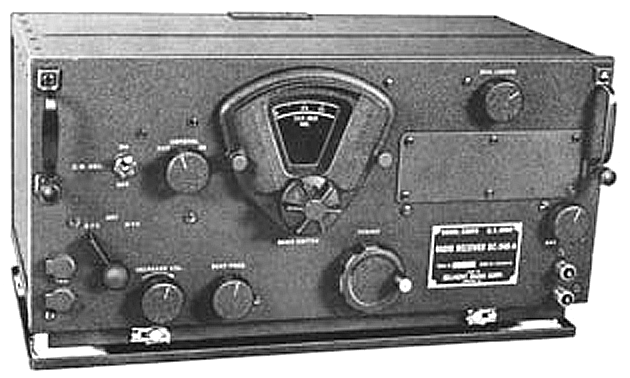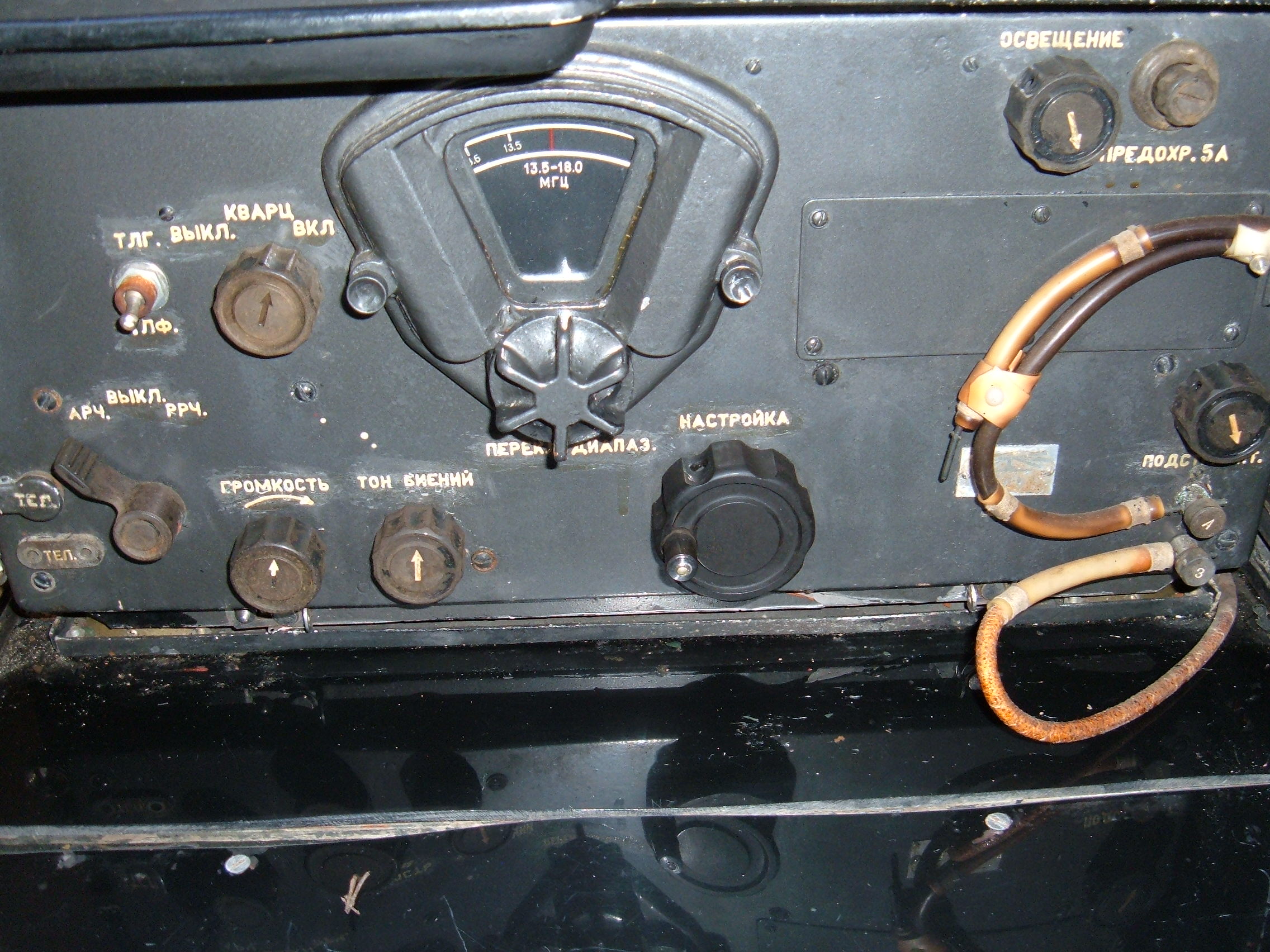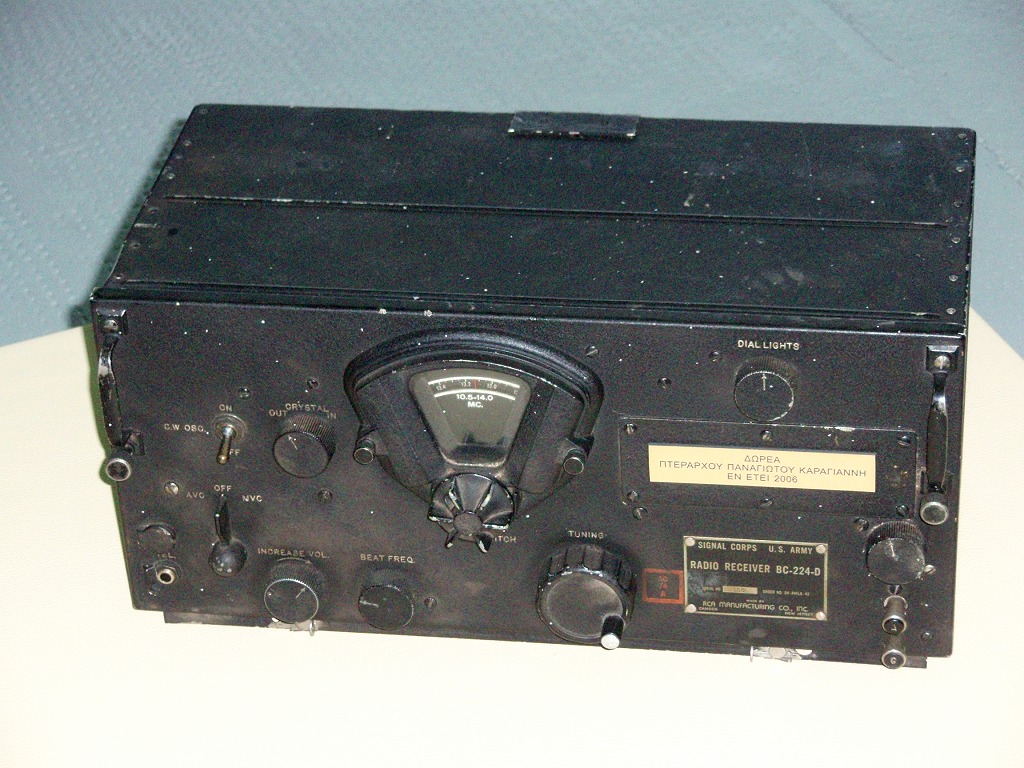BC-348 on:
[Wikipedia]
[Google]
[Amazon]
The BC-348 is a compact American-made 

 BC-348 receivers were copied and manufactured by the
BC-348 receivers were copied and manufactured by the
 The BC-224-A, -B, -C, and -D, and the BC-348-B, and -C, tuned 1.5-18
The BC-224-A, -B, -C, and -D, and the BC-348-B, and -C, tuned 1.5-18
communications receiver
A communications receiver is a type of radio receiver used as a component of a radio communication link. This is in contrast to a ''broadcast receiver'' which is used to receive radio broadcasts. A communication receiver receives parts of the r ...
, which was mass-produced during World War II
World War II or the Second World War, often abbreviated as WWII or WW2, was a world war that lasted from 1939 to 1945. It involved the vast majority of the world's countries—including all of the great powers—forming two opposin ...
for the U.S. Army Air Force
The United States Army Air Forces (USAAF or AAF) was the major land-based aerial warfare service component of the United States Army and ''de facto'' aerial warfare service branch of the United States during and immediately after World War II ...
. Under the joint Army-Navy nomenclature system, the receiver system became known as the AN/ARR-11.


History
The BC-348 is the 28 vdc powered version of the 14 vdc powered BC-224. The first version, the BC-224-A, was produced in 1936. Installed in almost all USAAF (and someUSN
The United States Navy (USN) is the maritime service branch of the United States Armed Forces and one of the eight uniformed services of the United States. It is the largest and most powerful navy in the world, with the estimated tonnage o ...
, some British and some Canadian) multi-engined transports and bombers used during the fifteen-year period from before World War II through the Korean War
, date = {{Ubl, 25 June 1950 – 27 July 1953 (''de facto'')({{Age in years, months, weeks and days, month1=6, day1=25, year1=1950, month2=7, day2=27, year2=1953), 25 June 1950 – present (''de jure'')({{Age in years, months, weeks a ...
, BC-348 radio receivers were easy to operate and reliable. Designed as LF/MF/HF receivers for use in larger aircraft (B-17, B-24, B-25, B-26, B-29, C-47, etc.), they were initially paired with a BC-375 transmitter in the ''SCR-287-A'' system. Late in World War II, the AN/ARR-11 (BC-348) was the receiver and the AN/ART-13A (ART-13 The AN/ART-13 was a radio transmitter manufactured by Collins Radio that found widespread use during and after World War II in military aircraft.
History
file:USS_Nereus_1952.jpg, US Navy (T-47/ART-13 Radio Transmitter) training on board the USS ...
) was the transmitter in the AN/ARC-8 system. They were also used in some ground and mobile installations such as the AN/MRC-20. The BC-348 series ran through several variations during its long production history, which included the BC-224. More than 100,000 of these receivers were produced, 80 percent by Belmont Radio and Wells-Gardner and the balance by RCA
The RCA Corporation was a major American electronics company, which was founded as the Radio Corporation of America in 1919. It was initially a patent trust owned by General Electric (GE), Westinghouse, AT&T Corporation and United Fruit Comp ...
and Stromberg-Carlson
Stromberg-Carlson was a telecommunications equipment and electronics manufacturing company in the United States. It was formed in 1894 as a partnership by Swedish immigrants Alfred Stromberg (1861 Varnhem, Sweden - 1913 Chicago) and Androv Ca ...
.
U.S.S.R.
The Soviet Union,. officially the Union of Soviet Socialist Republics. (USSR),. was a transcontinental country that spanned much of Eurasia from 1922 to 1991. A flagship communist state, it was nominally a federal union of fifteen national ...
following War II, by the Russian Vefon Works and labeled УС-9 (US-9 in English) The УС-9 continued to be produced in the Soviet Union through the 1970s, with such improvements as a solid state inverter to replace the dynamotor.http://nj7p.org/history/bc-348.html BC-224 AND BC-348 AIRCRAFT RADIO RECEIVERS
Enola Gay
The ''Enola Gay'' () is a Boeing B-29 Superfortress bomber, named after Enola Gay Tibbets, the mother of the pilot, Colonel Paul Tibbets. On 6 August 1945, piloted by Tibbets and Robert A. Lewis during the final stages of World War II, it be ...
, the B-29 Superfortress
The Boeing B-29 Superfortress is an American four-engined propeller-driven heavy bomber, designed by Boeing and flown primarily by the United States during World War II and the Korean War. Named in allusion to its predecessor, the B-17 Fl ...
bomber
A bomber is a military combat aircraft designed to attack ground and naval targets by dropping air-to-ground weaponry (such as bombs), launching aerial torpedo, torpedoes, or deploying air-launched cruise missiles. The first use of bombs dropped ...
that dropped "Little Boy
"Little Boy" was the type of atomic bomb dropped on the Japanese city of Hiroshima on 6 August 1945 during World War II, making it the first nuclear weapon used in warfare. The bomb was dropped by the Boeing B-29 Superfortress ''Enola Gay'' p ...
", the first atomic bomb
A nuclear weapon is an explosive device that derives its destructive force from nuclear reactions, either fission (fission bomb) or a combination of fission and fusion reactions (thermonuclear bomb), producing a nuclear explosion. Both bomb ...
on Hiroshima
is the capital of Hiroshima Prefecture in Japan. , the city had an estimated population of 1,199,391. The gross domestic product (GDP) in Greater Hiroshima, Hiroshima Urban Employment Area, was US$61.3 billion as of 2010. Kazumi Matsui h ...
, Japan
Japan ( ja, 日本, or , and formally , ''Nihonkoku'') is an island country in East Asia. It is situated in the northwest Pacific Ocean, and is bordered on the west by the Sea of Japan, while extending from the Sea of Okhotsk in the north ...
, was equipped with a BC-348 receiver as part of the aircraft's AN/ARC-8 system. Today, many examples of the BC-348 are restored and operated by vintage and military amateur radio enthusiasts.http://www.vmarsmanuals.co.uk/ VMARS Technical Information Service
The AN/ARC-8 system was still in service in older USAF aircraft in the early 1970s. At that time, military surplus dealers near Davis-Monthan Air Force Base in Tucson, Arizona, had stacks of the BC-348, that had been removed from aircraft, for sale to the public.
Specifications
 The BC-224-A, -B, -C, and -D, and the BC-348-B, and -C, tuned 1.5-18
The BC-224-A, -B, -C, and -D, and the BC-348-B, and -C, tuned 1.5-18 MHz
The hertz (symbol: Hz) is the unit of frequency in the International System of Units (SI), equivalent to one event (or cycle) per second. The hertz is an SI derived unit whose expression in terms of SI base units is s−1, meaning that one he ...
in six bands. The Signal Corps had the receiver design modified to add a 200-500 kHz
The hertz (symbol: Hz) is the unit of frequency in the International System of Units (SI), equivalent to one event (or cycle) per second. The hertz is an SI derived unit whose expression in terms of SI base units is s−1, meaning that on ...
band and compress the 1.5-18 MHz coverage into the remaining five bands. This modified design became the BC-224-E and the BC-348-E. The 200–500 kHz and 1.5-18 MHz tuning range remained constant for subsequent production of all models.
References
General references
*U. S. Army Signal Corps Technical Order No. 08-10-24, 12 June 1936, ''Instruction Book for Radio Receiver BC-224-A manufactured by RCA Manufacturing Co., Inc., Camden, N.J., U.S.A., Order No. SC-132373'' *Army Air Forces Technical Order No. 08-10-119, December 15, 1942; ''Instruction Book for Operation and Maintenance of Radio Receiver BC-348-E Radio Receiver BC-348-M Radio Receiver BC-348-P'' *U.S. Air Force Technical Order 12R2-3BC348-2, revised 15 April 1957; was AN 16-40BC-348-3, 21 June 1948; was AN 08-10-112, 17 July 1943, revised 18 December 1943, revised 30 July 1945; ''Handbook Maintenance Instructions Radio Receivers BC-348-J BC-348-N BC-348-Q'' *U.S. Air Force Technical Order 12R2-3BC-112, revised 15 April 1957; was AN 16-40BC224-2, 20 July 1945, revised 11 May 1948; ''Handbook Maintenance Instructions Radio Receivers BC-224-F BC-224-K BC-348-H BC-348-K BC-348-L BC-348-R''See also
* ARC-5 *ART 13 transmitter The AN/ART-13 was a radio transmitter manufactured by Collins Radio that found widespread use during and after World War II in military aircraft.
History
US Navy (T-47/ART-13 Radio Transmitter) training on board the USS Nereus, circa. 1952
In ...
*BC-610
The BC-610 was a radio transmitter based on the Hallicrafters HT-4 and was used by the U.S. Army Signal Corps during World War II.
History
In the early 1940s, the U.S. military sought a high-powered radio transmitter capable of infallible voice ...
*BC-654 The SCR-284 was a World War II era combination transmitter and receiver used in vehicles or fixed ground stations.
History
The Crosley Corporation of Cincinnati, Ohio manufactured the Signal Corps Radio set SCR-284 that consisted of the BC-6 ...
*Collins Radio
Rockwell Collins was a multinational corporation headquartered in Cedar Rapids, Iowa, providing avionics and information technology systems and services to government agencies and aircraft manufacturers. It was formed when the Collins Radio Compa ...
*Hammarlund super pro
The Hammarlund Super Pro was an American-made radio
Radio is the technology of signaling and communicating using radio waves. Radio waves are electromagnetic waves of frequency between 30 hertz (Hz) and 300 gigahertz (GHz). T ...
*National HRO
The original National HRO was a 9-tube HF (shortwave) general coverage communications receiver manufactured by the National Radio Company of Malden, Massachusetts, United States.
History
James Millen (amateur radio call sign W1HRX) in Massachus ...
*R-390A The R-390A /URR is a general coverage HF radio communications receiver designed by Collins Radio Company for the United States Armed Forces.
History
The R-390A military shortwave radio receiver was the result of a project undertaken by the United ...
{{DEFAULTSORT:BC 348
Military radio systems of the United States
World War II American electronics
Equipment of the United States Air Force
Telecommunications equipment
Radiofrequency receivers
Military equipment introduced in the 1930s